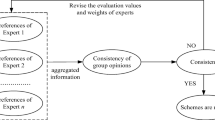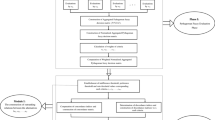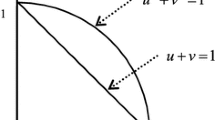Abstract
This study designs a novel decision support model to address group decision-making (GDM) problems with Pythagorean fuzzy linguistic information. To do so, a new concept of Pythagorean fuzzy linguistic preference relations (PFLPRs) is first introduced to describe fuzzy and uncertain information, where the Pythagorean fuzzy linguistic values (PFLVs) are represented by the linguistic membership degree and linguistic non-membership degree. Then, we also give the definitions of multiplicative consistency of PFLPRs, consistency index (CI), individual consensus degree (IGD) and group consensus degree (GCD). Subsequently, a consistency-adjustment approach is proposed to convert unacceptable multiplicative consistent PFLPRs into acceptable ones, as well as, derive the optimal normalized Pythagorean fuzzy priority weight vector (PFPWV) for alternatives. Furthermore, we design two algorithms in group decision support model. The first algorithm is used to check the multiplicative consistency of original PFLPRs and transform the unacceptable multiplicative consistent PFLPRs into the acceptable ones. The second algorithm is designed to aid the GCD to achieve the predefined level. The most innovative features of the proposed decision support model are following two points. One is that the GCD reaches the predefined level, while each PFLPR still keeps multiplicative consistency. The other is that it can preserve decision makers’ original preference information as much as possible. Finally, we give a numerical example to illustrate validity and practicality of this proposed approach.
Similar content being viewed by others
References
Atanassov K (1989) More on intuitionistic fuzzy sets. Fuzzy Sets Syst 33:37–46
Cabrerizo FJ, Al-Hmouz R, Morfeq A, Balamash AS, Martínez MA, Herrera-Viedma E (2017) Soft consensus measures in group decision making using unbalanced fuzzy linguistic information. Soft Comput 21:3037–3050
Celik E, Akyuz E (2018) An interval type-2 fuzzy AHP and TOPSIS methods for decision-making problems in maritime transportation engineering: the case of ship loader. Ocean Eng 155(1):371–381
Davoudabadi R, Mousavi SM, Mohagheghi V, Vahdani B (2019) Resilient supplier selection through introducing a new interval-valued intuitionistic fuzzy evaluation and decision-making framework. Arab J Sci Eng 44:7351–7360
Deng W, Xu JJ, Zhao HM, Song YJ (2020a) A novel gate resource allocation method using improved PSO-Based QEA. IEEE Trans Intell Transp Syst. https://doi.org/10.1109/TITS.2020.3025796
Deng W, Xu JJ, Song YJ, Zhao HM (2020b) Differential evolution algorithm with wavelet basis function and optimal mutation strategy for complex optimization problem. Appl Soft Comput J. https://doi.org/10.1016/j.asoc.2020.106724
Dong YC, Xu YF, Li HY (2008) On consistency measures of linguistic preference relations. Eur J Oper Res 189(2):430–444
Dong Y, Xiao J, Zhang H, Wang T (2016) Managing consensus and weights in iterative multiple-attribute group decision making. Appl Soft Comput 48:80–90
Ghorabaee MK, Amiri M, Zavadskas EK et al (2017) A new multi-criteria model based on interval type-2 fuzzy sets and EDAS method for supplier evaluation and order allocation with environmental considerations. Comput Ind Eng 112:156–174
Herrera F, Herrera-Viedma E (2000) Linguistic decision analysis: Steps for solving decision problems under linguistic information. Fuzzy Sets Syst 115(1):67–82
Herrera-Viedma E, Alonso S, Chiclana F, Herrera F (2007) A consensus model for group decision making with incomplete fuzzy preference relations. IEEE Trans Fuzzy Syst 15(5):863–877
Jin FF, Ni ZW, Pei LD, Chen HY, Li YP, Zhu XH, Ni LP (2019) A decision support model for group decision making with intuitionistic fuzzy linguistic preferences relations. Neural Comput Appl 31(2):1103–1124
Lin Y, Wang YM (2018) Group decision making with consistency of intuitionistic fuzzy preference relations under uncertainty. IEEE/CAA J Automat Sinica 5(3):1–9
Peng XD, Yang Y (2015) Some Results for Pythagorean Fuzzy Sets. Int J Intell Syst 30(11):1133–1160
Peng X, Yang Y (2016a) Fundamental properties of interval-valued Pythagorean fuzzy aggregation operators. Int J Intell Syst 31(5):444–487
Peng XD, Yang Y (2016b) Pythagorean fuzzy Choquet integral based MABAC for multiple attribute group decision making. Int J Intell Syst 31(10):989–1020
Pérez IJ, Cabrerizo FJ, Alonso S, Dong YC, Chiclana F, Herrera-Viedma E (2018) On dynamic consensus processes in group decision making problems. Information Science 459:20–35
Tian G et al (2019) Fuzzy grey Choquet integral for evaluation of multicriteria decision making problems with interactive and qualitative indices. IEEE Transactions on Systems, Man, and Cybernetics: Systems,. https://doi.org/10.1109/TSMC.2019.2906635
Wang L, Wang YM, Mart´ Inez L, (2017) A group decision method based on prospect theory for emergency situations. Inf Sci 135:119–135
Wang H, He S, Li C, Pan X (2019) Pythagorean uncertain linguistic variable Hamy mean operator and its application to multi-attribute group decision making. IEEE/CAA J Automat Sinica 6(2):527–539
Wei GW, Lu M, Tang XY, Wei Y (2018) Pythagorean fuzzy interaction aggregation operators and their application to multiple attribute decision making. J Intell Fuzzy Syst 33(6):1197–1233
Wu ZB, Xu JP (2012) A consistency and consensus based decision support model for group decision making with multiplicative preference relations. Decis Support Syst 52(3):757–767
Xu ZS (2004) A method based on linguistic aggregation operators for group decision making with linguistic preference relations. Inf Sci 166:19–30
Xu ZS (2005) Deviation measures of linguistic preference relations in group decision making. Omega 33:249–254
Yager RR (2014a) Pythagorean membership grades in multi-criteria decision making. IEEE Trans Fuzzy Syst 22(4):958–965
Yager RR (2014b) Pythagorean membership grades in multicriteria decision making. IEEE Trans Fuzzy Syst 22(4):958–965
Yager RR, Abbasov AM (2013) Pythagorean membership grades, complex numbers, and decision making. Int J Intell Syst 28(5):436–452
Yan HB, Ma T, Huynh VN (2017) On qualitative multi-attribute group decision making and its consensus measure: A probability based perspective. Omega 70:94–117
Yang Y, Qian GS, Ding H, Li YL (2019) Pythagorean fuzzy preference relations and its application to group decision making. Contr Decis 34(2):287–297
Yu WY, Zhang Z, Zhong QY (2019) Consensus reaching for MAGDM with multi-granular hesitant fuzzy linguistic term sets: a minimum adjustment-based approach. Ann Oper Res. https://doi.org/10.1007/s10479-019-03432-7
Zadeh LA (1975) The concept of a linguistic variable and its application to approximate reasoning. Inf Sci 8(3):199–249
Zhang XL, Xu ZS (2014) Extension of TOPSIS to multiple criteria decision making with Pythagorean fuzzy sets. Int J Intell Syst 29(12):1061–1078
Zhang Y, Ma HX, Liu BH, Liu J (2012) Group decision making with 2-tuple intuitionistic fuzzy linguistic preference relations. Soft Comput 16:1439–1446
Zhang Z, Yu WY, Martínez L, Gao Y (2020a) Managing multigranular unbalanced hesitant fuzzy linguistic information in multiattribute large-scale group decision making: A linguistic distribution-based approach. IEEE Trans Fuzzy Syst 28(11):2875–2889
Zhang Z, Gao Y, Li ZL (2020b) Consensus reaching for social network group decision making by considering leadership and bounded confidence. Knowl-Based Syst 204:1–11
Zhang Z, Kou XY, Yu WY, Gao Y (2020c) Consistency improvement for fuzzy preference relations with self-confidence: An application in two-sided matching decision making. J Oper Res Soc. https://doi.org/10.1080/01605682.2020.1748529
Zhou Y, Xu Y, Xu WH, Wang J, Yang GM (2020) A novel multiple attribute group decision-making approach based on interval-valued Pythagorean fuzzy linguistic sets. IEEE Access 8:176797–176817
Zhu B, Xu ZS (2014) Consistency measures for hesitant fuzzy linguistic preference relations. IEEE Trans Fuzzy Syst 22:35–45
Zhu B, Xu ZS, Xu JP (2014) Deriving a ranking from hesitant fuzzy preference: relations under group decision making. IEEE Trans Cybern 44:1328–1337
Acknowledgements
The work was supported by National Natural Science Foundation of China (Nos. 72071001, 71901001, 71871001, 71771001, 71701001), Humanities and Social Sciences Planning Project of the Ministry of Education (No. 20YJAZH066), Natural Science Foundation of Anhui Province (Nos. 2008085MG226, 2008085QG333), Key Research Project of Humanities and Social Sciences in Colleges and Universities of Anhui Province (Nos. SK2019A0013, SK2020A0038), Natural Science Foundation for Distinguished Young Scholars of Anhui Province (No. 1908085J03).
Author information
Authors and Affiliations
Contributions
All authors contributed to the study conception and design. Material preparation, data collection and analysis were performed by JL, MF, FJ, ZT, HC and PD. The first draft of the manuscript was written by JL, and all authors commented on previous versions of the manuscript. All authors read and approved the final manuscript.
Corresponding author
Ethics declarations
Conflict of interest
The authors declare that they have no conflict of interest.
Additional information
Publisher's Note
Springer Nature remains neutral with regard to jurisdictional claims in published maps and institutional affiliations.
Appendix
Appendix
Proof of Theorem 1
At first, we demonstrate the necessary part. If PFLPR \(A = \left( {a_{ij} } \right)_{n \times n}\) is multiplicative consistent, based on Definition 4, we can get
As \(a_{ij\mu } = a_{ji\upsilon } ,\;a_{ij\upsilon } = a_{ji\mu },\) we can get \(I\left( {a_{ij\mu } } \right)I\left( {a_{kj\upsilon } } \right)I\left( {a_{ik\upsilon } } \right) = I\left( {a_{ik\mu } } \right)I\left( {a_{kj\mu } } \right)I\left( {a_{ij\upsilon } } \right),\;i,j,k \in N,\) then
Thus, it can deduce the following result on the basis of Eq. (31), \(\Phi \left( {a_{ij} } \right) = \Phi \left( {a_{ik} } \right) \cdot \Phi \left( {a_{kj} } \right),\quad i,j,k \in N\). Then, we prove the sufficient section.
As \(\Phi \left( {a{}_{ij}} \right) = \Phi \left( {a_{ik} } \right) \cdot \Phi \left( {a_{kj} } \right),\;i,j,k \in N\) and \(\Phi \left( {a_{ij} } \right) = \frac{{I\left( {a_{ij\mu } } \right)}}{{I\left( {a_{ij\upsilon } } \right)}}\), we can get
Next, we obtain the new formula \(I\left( {a_{ij\mu } } \right)I\left( {a_{ik\upsilon } } \right)I\left( {a_{kj\upsilon } } \right) = I\left( {a_{ij\upsilon } } \right)I\left( {a_{ik\mu } } \right)I\left( {a_{kj\mu } } \right),\;i,j,k \in N.\) As \(a_{ij\mu } = a_{ji\upsilon } ,\;a_{ij\upsilon } = a_{ji\mu } ,\;i,j \in N,\) we have \(I\left( {a_{ij\mu } } \right)I\left( {a_{jk\mu } } \right)I\left( {a_{ki\mu } } \right) = I\left( {a_{ik\mu } } \right)I\left( {a_{kj\mu } } \right)I\left( {a_{ji\mu } } \right),\;i,j,k \in N,\) which proves that PFLPR \(A = \left( {a_{ij} } \right)_{n \times n}\) is multiplicative consistent.
Proof of Theorem 2
As PFLPR \(A = \left( {a_{ij} } \right)_{n \times n}\) is multiplicative consistent, then we get \(\Phi \left( {a_{ij} } \right) = \Phi \left( {a_{ik} } \right) \cdot \Phi \left( {a_{kj} } \right),\;i,j,k \in N\). If \(\Phi \left( {a_{ik} } \right) \ge 1\) and \(\Phi \left( {a_{kj} } \right) \ge 1\), then \(\Phi \left( {a_{ij} } \right) = \Phi \left( {a_{ik} } \right) \cdot \Phi \left( {a_{kj} } \right) \ge 1\), for any \(i,j,k \in N\). Based on Definition 5, the proof of Theorem 2 is accomplished.
Proof of Theorem 3
The optimal deviation values are \(\tilde{s}_{ij}^{ + } ,\tilde{s}_{ij}^{ - } ,\tilde{r}_{ij}^{ + } ,\tilde{r}_{ij}^{ - } ,i,j \in N\) and \(\tilde{\omega } = \left( {\tilde{\omega }_{1} ,\tilde{\omega }_{2} , \ldots ,\tilde{\omega }_{n} } \right)^{T}\) is the optimal normalized PFPWV in Model 2, then for any \(i,j,k \in N\), we get
Based on Eqs. (33) and (34),we can get
therefore, according to Eq. (17), we can obtain that \(\tilde{a}_{ij\mu } = I^{ - 1} \left( {\sqrt {\tilde{\omega }_{i\mu } \tilde{\omega }_{j\upsilon } } } \right)\) and \(\tilde{a}_{ij\upsilon } = \sqrt {\omega_{i\upsilon } \omega_{j\mu } } ,\quad i \ne j.\)
According to Corollary 1, it can certified that the PFLPR \(A = \left( {a_{ij} } \right)_{n \times n} = \left( {\left\langle {a_{ij\mu } ,a_{ij\upsilon } } \right\rangle } \right)_{n \times n}\) is multiplicative consistent. The proof of Theorem 3 is accomplished.
Proof of Theorem 5
It is obvious that (i) and (iii) are valid and correct. Next, we can present the proof of (ii) and (iv).
As \(a_{ij\mu } = a_{ji\upsilon }\), \(a_{ij\upsilon } = a_{ji\mu }\), \(b_{ij\mu } = b_{ij\upsilon }\), \(b_{ij\upsilon } = b_{ji\mu }\), \(i,j \in N\), then
Based on Eq. (18), we can get
then the proof of Theorem 5 is accomplished.
Proof of Theorem 6
As \(A_{k} = \left( {a_{ij,k} } \right)_{n \times n} \left( {k \in M} \right)\) be a collection of PFLPRs, based on Definition 1, we can get \(a_{ij\mu ,k} = a_{ji\upsilon ,k}\),\(a_{ij\upsilon ,k} = a_{ji\mu ,k}\),\(I^{2} \left( {a_{ij\mu ,k} } \right) + I^{2} \left( {a_{ij\upsilon ,k} } \right) \le 1\;,\quad \forall i,j \in N,k \in M\), then \(a_{ij\mu ,c} = I^{ - 1} \left( {\prod\nolimits_{k = 1}^{m} {\left( {I\left( {a_{ij\mu ,k} } \right)} \right)^{{\lambda_{k} }} } } \right) = I^{ - 1} \left( {\prod\nolimits_{k = 1}^{m} {\left( {I\left( {a_{ji\upsilon ,k} } \right)} \right)^{{\lambda_{k} }} } } \right) = a_{ji\upsilon ,c}\). According to Eq. (25), we can get \(I\left( {a_{ij\mu ,c} } \right) = \prod\nolimits_{k = 1}^{m} {\left( {I\left( {a_{ij\mu ,k} } \right)} \right)}^{{\lambda_{k} }},\) \(I\left( {a_{ij\upsilon ,c} } \right) = \prod\nolimits_{k = 1}^{m} {\left( {I\left( {a_{ij\upsilon ,k} } \right)} \right)}^{{\lambda_{k} }} ,\quad i,j \in N.\) Since \(I\left( {a_{ij\mu ,k} } \right),I\left( {a_{ij\upsilon ,k} } \right) \in [0,1],\) \(i,j \in N,\;k \in M,\) by Lemma 1, we get
\(0 \le I\left( {a_{ij\mu ,c} } \right) = \prod\nolimits_{k = 1}^{m} {\left( {I\left( {a_{ij\mu ,k} } \right)} \right)}^{{\lambda_{k} }} \le \sum\nolimits_{k = 1}^{m} {\lambda_{k} I\left( {a_{ij\mu ,k} } \right)} \le 1 \cdot \sum\nolimits_{k = 1}^{m} {\lambda_{k} } = 1,\)
\(0 \le I\left( {a_{ij\upsilon ,c} } \right) = \prod\nolimits_{k = 1}^{m} {\left( {I\left( {a_{ij\upsilon ,k} } \right)} \right)}^{{\lambda_{k} }} \le \sum\nolimits_{k = 1}^{m} {\lambda_{k} I\left( {a_{ij\upsilon ,k} } \right)} \le 1 \cdot \sum\nolimits_{k = 1}^{m} {\lambda_{k} } = 1,\) it can obtain that \(s_{0} \le a_{ij\mu ,c} \le s_{2\tau }\) and \(s_{0} \le a_{ij\upsilon ,c} \le s_{2\tau } ,\quad i,j \in N.\) Furthermore, as \(I^{2} \left( {a_{ij\mu ,k} } \right) + I^{2} \left( {a_{ij\upsilon ,k} } \right) \in [0,1],i,j \in N,k \in M\), according to Lemma 1, we have
then \(I^{2} \left( {a_{ij\mu ,c} } \right) + I^{2} \left( {a_{ij\upsilon ,c} } \right) \le 1,\quad i,j \in N\).
Based on Definition 2, it is proved that \(A_{c} = \left( {a_{ij,c} } \right)_{n \times n}\) is a PFLPR. The proof of Theorem 6 is accomplished.
Proof of Theorem 7
Suppose that \(\tilde{s}_{ij,k}^{ - } ,\tilde{s}_{ij,k}^{ + } ,\tilde{r}_{ij,k}^{ - } ,\tilde{r}_{ij,k}^{ + } ,i,j \in N,k \in M\) be the most desirable deviation values, as well as, \(\tilde{s}_{ij,c}^{ + } ,\tilde{s}_{ij,c}^{ - } ,\tilde{r}_{ij,c}^{ + } ,\tilde{r}_{ij,c}^{ - } ,i,j \in N,k \in M\) be the optimal deviation values, and then we have
Let \(\tilde{A}_{c} = \left( {\tilde{a}_{ij,c} } \right)_{n \times n} = \left( {\left\langle {\tilde{a}_{ij\mu ,c} ,\tilde{a}_{ij\upsilon ,c} } \right\rangle } \right)_{n \times n}\) and \(\tilde{A}_{k} = \left( {\tilde{a}_{ij,k} } \right)_{n \times n} = \left( {\left\langle {\tilde{a}_{ij\mu ,k} ,\tilde{a}_{ij\upsilon ,k} } \right\rangle } \right)_{n \times n}\), for \(\forall i,j \in N,k \in M\), we can get
Based on Theorem 3, it is notable that \(\tilde{A}_{k} \left( {k \in M} \right)\) and \(A_{c}\) are the multiplicative consistent PFLPRs.
According to Eqs. (41) and (42), we get \(I\left( {\tilde{a}_{ij\mu ,k} } \right) = I\left( {a_{ij\mu ,k} } \right) \cdot \exp \left( {\tilde{s}_{ij,k}^{ - } - \tilde{s}{}_{ij,k}^{ + } } \right),\) \(I\left( {\tilde{a}_{ij\upsilon ,k} } \right) = I\left( {a_{ij\upsilon ,k} } \right) \cdot \exp \left( {\tilde{r}_{ij,k}^{ - } - \tilde{r}_{ij,k}^{ + } } \right),\quad i,j \in N,k \in M,\) \(I\left( {\tilde{a}_{ij\mu ,c} } \right) = I\left( {a_{ij\mu ,c} } \right) \cdot \exp \left( {\tilde{s}_{ij,c}^{ - } - \tilde{s}_{ij,c}^{ + } } \right),\) \(I\left( {\tilde{a}_{ij\upsilon ,c} } \right) = I\left( {a_{ij\upsilon ,c} } \right) \cdot \exp \left( {\tilde{r}_{ij,c}^{ - } - \tilde{r}_{ij,c}^{ + } } \right),\quad i,j \in N,\) it can obtain that
Based on \(CI\left( {A_{k} } \right) < \overline{CI} ,k \in M\), we can obtain the following formula by Eqs. (39), (42) and (43),
then the proof of Theorem 7 is completed.
Rights and permissions
About this article
Cite this article
Liu, J., Fang, M., Jin, F. et al. Pythagorean fuzzy linguistic decision support model based on consistency-adjustment strategy and consensus reaching process. Soft Comput 25, 8205–8221 (2021). https://doi.org/10.1007/s00500-021-05747-9
Accepted:
Published:
Issue Date:
DOI: https://doi.org/10.1007/s00500-021-05747-9




